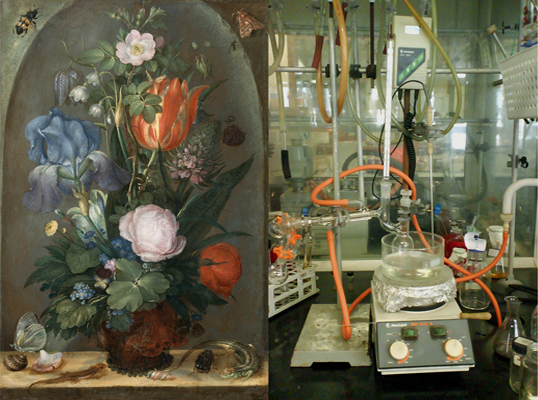De-Stilling Still Life

























DE-STILLING STILL LIFE (after Brueghel)
After carefully indexing and actually growing all the elements (plants, animals, wood) of the painting in a laboratory setting, they became distilled with a distilling apparatus transforming them into the essence of the still life painting.
The departure point for the work De-stilling Still Life emerged from the research into the links between the floral still-life paintings and the cut-flower industry. Drawing our inspiration for this distillation from Bloemen in a Vase (~1617), painting by Jan Brueghel the elder (collection the Koninklijk Museum voor Schone Kunsten Antwerpen) we were able to identify and inventarise the encyclopedic array of flowers depicted in Brueghel’s painting.
The distilling apparatus is the vehicle to transport our studies and artistic ideas. We think of the distilling apparatus as an analogue machine, acting as a hydraulic computer processing all the still-life ingredients. The ingredients being not only what is seen in the image, but also the invisible ingredients, thus making an essence of complex relational fabric: such as the allegorical meaning of the painting’s subject and the different economic, social and aesthetic dynamics needed to re-assemble and make this still-life come alive today.
Tangential Thoughts
The development of the still-life in the early 1600s was synonymous with the increasing urbanisation of Dutch and Flemish society. Arguably, the emphasis on commerce, trade and market speculation in buying and selling abstract commodities was the ‚bulb’ of high capitalism. Tulips often appear in Netherlands, and Flemish floral still-lifes.
On the one hand, still lifes drew attention to the carnality and decay of life and the stern judgement of God, however, it could be argued that the painted depiction of these priceless, unobtainable luxury goods (especially tulips) in still-lifes is itself materialisation of an (im)material desire, the tulips among the array of flowers, are, a brand of something that can be never fully grasped: Possessing a still-life demonstrates the ability of an individual to attain a Godlike
power through the merits of his entrepreneurial skills and associated wealth. Perhaps the presence of a rare tulip in still-life paintings is the first instance of branding. Tulip mania (1633-37), was the first time, investor invest in something they had no direct connection to, the capital economy attained an increasingly abstract yet pervasive role in the political and cultural fabric.
Breaking-down the cultural impasse.
By re-assembling the still-life, we want to playfully challenge the historical and contemporary human centricsm — the intervention of humans and how we have, over many centuries culturalised nature. The Netherlands in particular, is a country which is almost completey culturalised. It’s a territory that exists with thanks to the feat of human engineering and control. Agriculture is a simplification of the nature it has replaced. In a way, our cultural relation to nature is a kind of disembodied agriculture.
Concept and idea: Nikolaus Gansterer and Wietske Maas.
Year: 2006 – 2011
Materials: Distilling apparatus, tubes, various plants, specimen, drawings, video, blackboards, …
Exhibited at:
– 2007 „Erst das Fressen“, Museum Hessenhuis, Antwerpen
– 2008 „KAAP Biennale“, Fort Ruigenhoek, Utrecht;
– 2010/11 „Story behold. Story be told“, Kunsthistorisches Museum, Gemäldegalerie, Vienna.
Learn more about the entire research process of the project and its presentations at KHM Kunsthistorisches Museum, Vienna, Austria:
http://www.de-stilling-still-life.info

